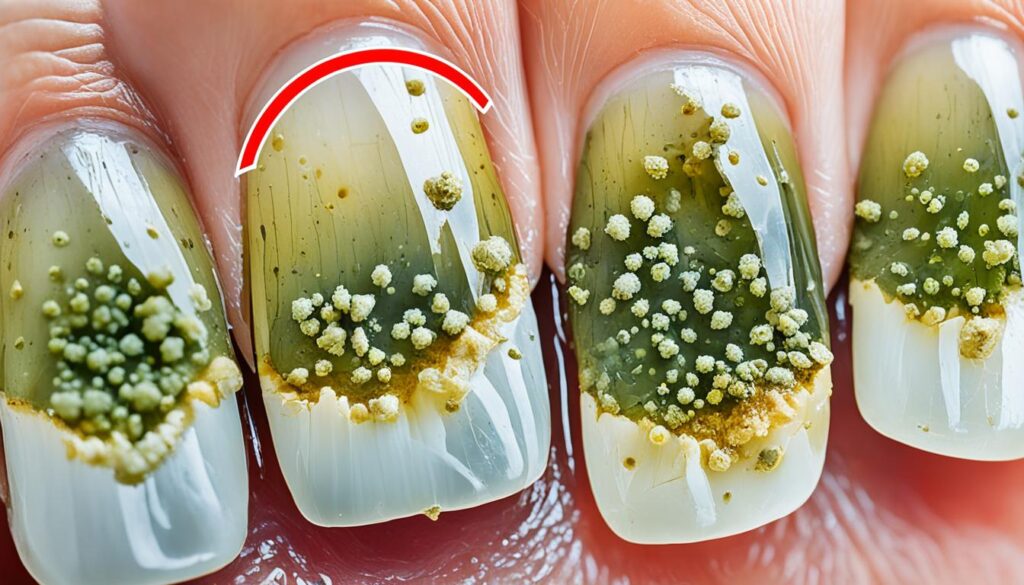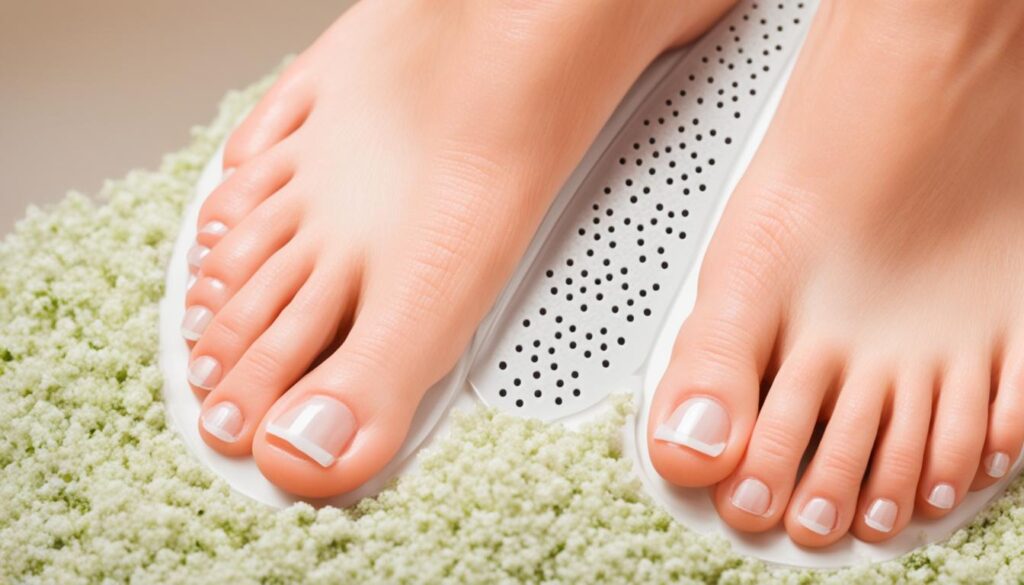
Effective Mold Toenail Fungus Treatments & Tips
Mold toenail fungus can be an unsightly and uncomfortable condition that affects many people. If you’re dealing with this common fungal infection, you’re not alone. The good news is that there are effective treatments and strategies to combat mold toenail fungus and restore healthy nails.
In this section, we will explore proven methods to eliminate mold toenail fungus and prevent its recurrence. From medical treatments to home remedies and lifestyle changes, we’ll cover a range of options to help you regain confidence in your feet.
Key Takeaways:
- Understanding the causes and symptoms of mold toenail fungus is essential for effective treatment.
- Medical treatments, including antifungal medications, can help eliminate the fungus.
- Home remedies, such as vinegar soaks and essential oils, may offer relief.
- Maintaining proper foot hygiene and avoiding certain environments can prevent recurrence.
- Be patient and consistent with your treatment plan to achieve optimal results.
Understanding Mold Toenail Fungus
Before delving into effective treatments for mold toenail fungus, it is crucial to have a comprehensive understanding of the condition itself. Mold toenail fungus, also known as onychomycosis, is a common fungal infection that affects the nails.
Mold toenail fungus typically starts as a small white or yellow spot under the tip of the nail and gradually spreads deeper, leading to discoloration, thickening, and crumbling of the nail. If left untreated, it can cause discomfort, pain, and even difficulty walking.
This type of toenail fungus is caused by various molds and fungi, including dermatophytes, yeasts, and non-dermatophytes. It often thrives in warm and moist environments, such as public swimming pools, gyms, and showers. Additionally, factors such as poor foot hygiene, wearing tight or non-breathable shoes, and having a weakened immune system can increase the risk of developing mold toenail fungus.
Common symptoms of mold toenail fungus include:
- Discolored nails, ranging from white, yellow, brown, or black
- Thickened nails
- Brittle or crumbly nails
- Nail pain or discomfort
- Unpleasant odor
- Nail separation from the nail bed
If you are experiencing any of these symptoms or suspect you have mold toenail fungus, it is essential to consult a healthcare professional for an accurate diagnosis and appropriate treatment.
To shed more light on mold toenail fungus and its development, let’s take a closer look at the causes, symptoms, and risk factors associated with this common fungal infection:
| Causes | Symptoms | Risk Factors |
|---|---|---|
|
|
|
By gaining a deeper understanding of mold toenail fungus and its causes, symptoms, and risk factors, individuals can take the necessary steps to prevent the infection and seek appropriate treatment if needed. In the next section, we will explore proven treatments for mold toenail fungus.
Proven Treatments for Mold Toenail Fungus
In this section, we will explore various treatment options that have been proven effective in combating mold toenail fungus. Whether you prefer medical treatments, home remedies, or lifestyle changes, there are solutions to help you eliminate the fungus and restore healthy nails.
Medical Treatments
If your mold toenail fungus is severe or persistent, medical treatments may be necessary. Consult with a healthcare professional who can prescribe the appropriate medications. Here are some commonly used medical treatments:
- Oral Antifungal Medications: These medications are taken by mouth and work from within to eradicate the fungus. They are typically prescribed for a period of several weeks to months.
- Topical Antifungal Creams: Creams or ointments containing antifungal agents can be applied directly to the affected nails. Regular and consistent application is essential for effectiveness.
- Nail Debridement: In some cases, your healthcare professional may trim or remove the infected nails to enhance the effectiveness of topical treatments.
Home Remedies
Many individuals prefer to try natural remedies to treat mold toenail fungus. While these remedies may not have scientific evidence to support their effectiveness, some people find them helpful. Here are a few popular home remedies:
- Vinegar Soaks: Soaking your affected nails in a solution of vinegar and water may help fight the fungus. Mix equal parts of vinegar and water in a basin, soak your feet for 15-20 minutes, and then dry thoroughly.
- Tea Tree Oil: Known for its antifungal properties, tea tree oil can be applied directly to the affected nails using a clean cotton swab. Repeat this process daily until the fungus clears up.
- Garlic: Garlic has natural antifungal properties. Crush a few garlic cloves to create a paste and apply it to the affected nails. Cover your feet with socks and leave it overnight. Rinse your feet in the morning.
Lifestyle Changes
Adopting certain lifestyle changes can complement medical treatments and home remedies, increasing their effectiveness and preventing future fungal growth. Consider the following lifestyle changes:
- Maintain Good Foot Hygiene: Keep your feet clean and dry, especially after activities that cause them to sweat. Regularly trim your nails and avoid sharing nail clippers or other personal care items.
- Avoid Walking Barefoot in Public Areas: Wear protective footwear, such as flip-flops or sandals, in public places like gym showers, locker rooms, and pool areas to reduce the risk of fungal exposure.
- Choose Breathable Footwear: Opt for shoes made of breathable materials like leather or canvas to allow air circulation around your feet.
| Treatment | Description | Pros | Cons |
|---|---|---|---|
| Oral Antifungal Medications | Taken by mouth to eradicate the fungus from within | – Effective for severe or persistent cases – Systemic action – Convenient administration |
– Potential side effects – Require prescription – May interact with other medications |
| Topical Antifungal Creams | Applied directly to the affected nails | – Easy to use – Can be used in mild to moderate cases – Minimal side effects |
– Results may vary – Require regular application – Takes time to see improvement |
| Nail Debridement | Trimming or removal of infected nails | – Enhances the effectiveness of topical treatments – Can be performed by a healthcare professional |
– Temporary measure – May cause pain or discomfort – Nails take time to regrow |

Now that you have explored various mold toenail fungus treatments including medical treatments, home remedies, and lifestyle changes, you have the knowledge to make an informed decision. Remember to consult with a healthcare professional for a personalized treatment plan tailored to your specific needs.
Preventing Mold Toenail Fungus
Prevention is always better than cure. Taking proactive measures to prevent mold toenail fungus is essential in maintaining healthy nails. By following these prevention tips and practices, you can minimize the risk of recurring fungal infections.
- Maintain Proper Foot Hygiene: Keeping your feet clean and dry is crucial in preventing mold toenail fungus. Wash your feet regularly with soap and warm water, paying close attention to the spaces between your toes. After washing, make sure to thoroughly dry your feet, especially the toenail areas, to prevent moisture buildup.
- Trim Nails Carefully: Trim your nails straight across and avoid cutting them too short. Be cautious not to damage the surrounding skin or cuticles, as this can provide an entry point for fungal infections.
- Choose Breathable Footwear: Opt for shoes that allow proper ventilation, such as those made from breathable materials like leather or mesh. Avoid tight-fitting shoes or those that retain moisture, as they can create a favorable environment for fungal growth.
- Wear Protective Footwear in Public Areas: When using public pools, gyms, or communal showers, wear waterproof sandals or flip-flops to protect your feet from coming into direct contact with potentially contaminated surfaces.
- Avoid Sharing Personal Items: Refrain from sharing socks, shoes, or nail clippers with others to prevent the transmission of fungal infections. Additionally, avoid using common nail care tools or equipment without proper sterilization.
- Practice Regular Nail Checks: Regularly inspect your toenails for any signs of fungal infection, such as discoloration, thickening, or brittleness. Early detection allows for prompt treatment, reducing the risk of further complications.
- Manage Moisture: Moisture is a common catalyst for mold toenail fungus. Ensure your feet are adequately dry before putting on socks or shoes. Consider using antifungal foot powders or sprays to control excess moisture and maintain dryness.
- Choose Breathable Socks: Opt for moisture-wicking socks made from natural fibers like cotton or wool. These materials help absorb excess sweat and promote better airflow, reducing the chances of fungal growth.
By incorporating these prevention tips into your daily routine, you can significantly reduce the risk of mold toenail fungus and maintain healthy, fungus-free nails.

Conclusion
In conclusion, tackling mold toenail fungus requires a multi-faceted approach. By understanding the causes, implementing effective treatments, and adopting preventive measures, you can successfully overcome this common fungal infection.
It is essential to educate yourself about mold toenail fungus, including its causes, symptoms, and risk factors. This knowledge will help you identify the infection early and seek appropriate treatment.
When it comes to treatments, both medical options and natural remedies can be effective. Consult with a healthcare professional to determine the best course of action based on the severity of your condition. Additionally, embrace preventive measures like maintaining good foot hygiene, avoiding moist environments, and wearing breathable footwear to prevent future infections.
Remember, healthy nails are within reach. Take action today and regain your confidence with fungus-free feet. Don’t let mold toenail fungus hold you back from enjoying life to the fullest.




